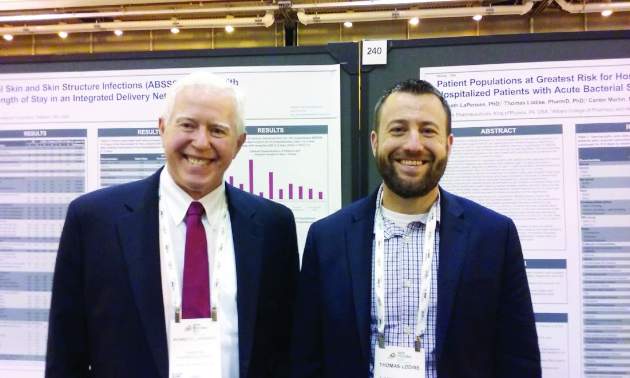AT ASM MICROBE 2017
NEW ORLEANS (FRONTLINE MEDICAL NEWS) – Approximately 20% of patients treated with vancomycin for an acute bacterial skin and skin structure infection remained in the hospital 8 days or longer, and about 7% experienced a readmission within 30 days, a retrospective study of 507 patients in the Geisinger Health System database showed.
“We found, for those who had a readmission, the major drivers were those who are your ‘health care frequent flyers’ – those who were admitted in the past 6 months,” said Thomas Lodise, PharmD, PhD, professor of pharmacy practice at Albany (N.Y.) College of Pharmacy and Health Sciences. “So, patients with a previous hospitalization are more likely to be treated again for all-cause admission within 30 days of discharge.” In addition, people with a lower-extremity abscess, particularly older patients with diabetes, and those with a traumatic wound were also more likely to return within 30 days.
“These patients with diabetes and lower-extremity infection need more attention, because they’re more likely to come back,” Dr. Lodise said during a poster session at the annual meeting of the American Society for Microbiology.
Identifying the population at highest readmission risk could become more important soon. “Even though hospitals are not penalized for skin infection readmissions, there is some talk of adding that to the Medicare penalty,” Dr. Lodise said.
“It’s under review now by Medicare,” said Kenneth LaPensee, PhD , a consultant for Paratek Pharmaceuticals, King of Prussia, Pa., a firm developing an antibiotic to treat patients with an acute bacterial skin and skin structure infection (ABSSSI).
Dr. Lodise, Dr. LaPensee, and their colleagues studied adults hospitalized for an ABSSSI primary diagnosis based on ICD-9 codes and treated with at least 2 days of vancomycin. Participants were seen within the integrated Geisinger Health System between 2010 and 2015.
A total 6.9% of patients were readmitted within 30 days or had repeat emergency department visits. That group included more people with a body mass index of 36 kg/m2 or greater – 8.4%, compared with 6.2% of those with a BMI of less than 36. Other factors associated with readmission included smoking or a history of smoking (9.8% vs. 2.7% for nonsmokers) and a history of ABSSSI not requiring hospitalization vs. no prior history of ABSSSI, 22.2% vs. 6.6%, respectively.
In addition, those with a prior hospital admission not related to skin and skin structure infection were at higher risk, 8.8%, compared with 6.3% for those with no prior hospital admission. A prior hospital outpatient visit was likewise associated with a higher risk for readmission, 12.0%, compared with 5.4% without such a history.
Greater disease severity did not appear to correlate with a higher risk of 30-day readmission in the study. The researchers compared the groups by both Eron classification and the Charlson Comorbidity Index disease severity measures.
“People with more comorbidities had higher readmission rates, but it wasn’t statistically significant,” Dr. Lodise said. Also, “we saw some signaling – like with older age and some differences with race – [that] nonwhites were more likely to get readmitted. A total 6.7% of readmissions were among people older than 65 years, compared with 7.2% of younger people.” Advanced age was a factor in the bivariate analysis, but not in the logistic regression, Dr. LaPensee said.
“We’re going to repeat this in a larger data set. We’re planning for 10,000 patients,” Dr. Lodise said. “In our next cohort, we’ll be able to delineate more patient covariates.” An unanswered question is whether treatment with an agent other than vancomycin could improve readmission rates.
Using the same Geisinger database, the investigators also examined prolonged length of stay for patients with ABSSSIs treated with vancomycin. Almost one-fifth, 19.9%, met their definition of a prolonged stay of 8 days or longer.
The average length of stay was 7 days. “We were a bit surprised. We anticipated it being closer to 4 or 5 days,” Dr. Lodise said. “Then we wanted to find out who are these patients with these prolonged lengths of stay?
“The interesting thing was, things you think would be predictive, like increased age or high BMI [body mass index], were not,” Dr. Lodise said. “But what we did find is being elderly with diabetes and having a lower-extremity infection or a lower-extremity infection with an abscess – this was the group at greatest risk for a prolonged length of stay.” Those findings make sense, he added, because those patients tend to be slow responders, and because intravenous vancomycin has no oral, step-down formulation.
Unlike the readmission risk factors, Eron disease severity “was … very predictive of a prolonged length of stay,” Dr. Lodise said.
“These are really correlated – those patients with longer length of stay are more likely to get readmitted,” Dr. Lodise said. “In these more-difficult-to-treat patient populations, they really need more attention [to figure out] what is going on with them, why they keep coming back to the hospital, or why are they staying in so long.”
Dr. Lodise is a consultant for Paratek Pharmaceuticals, the study sponsor. Dr. LaPensee is a Paratek employee.





